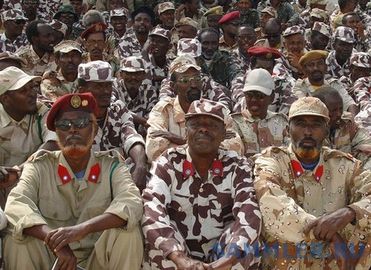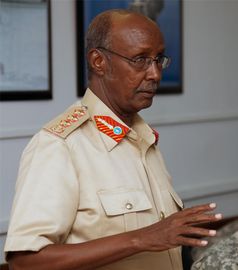Вооружённые силы Сомали
Материал из ВикиВоины
Вооружённые силы Сомали или SNAF (сокр. от Somali National Armed Forces) — военная организация Сомали, предназначенная для защиты свободы, независимости и территориальной целостности государства.
История[править]
The Somali Democratic Republic attained independence in 1960. Having been divided by Britain and Italy in the colonial period, the two former colonies were merged to form one territory. After a restless period of civilian poUtical government, the army staged a coup in 1969, and the military-dominated Supreme Revolutionary Council has ruled Somalia since that date. Somaha's national problems are unique in sub-Saharan Africa. Unlike the vast majority of black African States, Somaha is a nation — a country of one homogeneous ethnic group with its own traditions, culture and language. But sections of the Somali nation lie outside the frontiers drawn by Britain, France, Italy and Ethiopia: the Somalis claim that north-east Kenya, Djibouti and the Haud and Ogaden areas of Ethiopia are also part of the SomaH nation. Such divisions as exist in the country itself, and which have been, and in some respects still are, serious, are caused in part also by the differing colonial legacies (a north versus south friction) , and, more seriously and in rather larger part, by the comphcated clan system of the Somali people — there are six major clans, and until 1969 much political restlessness was caused by clan rivalries. Since the coup, and the heavily Marxist— Leninist pro-Soviet (until 1977) stance of the regime of General Muhammad Siyad Barre, there have also been a few signs of a new friction, that between the Socialist Revolutionaries and more traditional Muslims.
Somalia is a country of very limited economic resources, and of a low overall education level. Both these factors will impede recovery. Above all recovery will need a generous patron; despite the Ogaden disaster it is not impossible that the Soviet Union may once again reassume this role. The Soviet Union would certainly like to do so, and there are not likely to be other candidates. The role might even extend to support for some Somah face-saving move against Kenya. Somaha tends to be a prisoner of its own powerful rhetoric and irredentist passions; these have led the country to overconfidence in it own abilities. Whether the Ogaden events have led to cooler, more realistic appraisals is unclear: such appraisals should certainly not be presumed.
Организация[править]
The 19member Supreme Revolutionary Council (S.R.C.), of which General Muhammad Siyad Barre is the President, rules the country; it is assisted by a 'Council of Secretaries' — some 20 quasi- ministerial portfoho holders, mainly civilians. Since 1974 there has also been a Security Committee of the S.R.C., composed of a brigadier and two colonels as members, and one of the S.R.C.'s vice-presidents, Major-General Muhammad Ali Samater, as Chairman. He is also Minister for Defence. General Omar Haji Masala is the Army Commander. Masala is of the same clan as Siyad Barre, Samater comes from a group hitherto underprivileged. ROLE, COMMITMENT, DEPLOYMENT AND RECENT OPERATIONS A major reason for the very large Somah miUtary estabhshment is the wish to recover the lost, foreign-held, Somali areas. Prior to the Ethiopian Revolution httle activity took place against this powerful neighbour, but groups of insurgents (the 'shifta') operated against Kenya in 1964—5. The apparent collapse of power and authority in Addis Ababa, together with Ethiopia's Eritrean and Sudanese border problems led the Somahs to enter Ethiopia in 1977. The operations were entrusted to a 'West Somalia Liberation Front' , which by its equipment and training appears to have been largely selected units and personnel of the SomaU army under an ahas. Another 'Abo Liberation Front' operated in south Ethiopia, and was also a largely SomaU army force. The W.S.L.F., clearly meeting with mass popular approval in the Ogaden, took the tov^m of Jijiga and advanced to the gates of Harar. Here it was held in check, Cuban reinforcements and Soviet-led Ethiopian units were brought to the area and in February —March, 1978 the Somalis were ejected, suffering severe losses in both manpower and equipment. The out-of-date Soviet equipment, poorly maintained and used in the hands of poorly trained Somali soldiers or insurgents proved no match for the Cubans and the Soviet-trained Ethiopians with more up-to-date and better-serviced armour and artillery. The Somalis appear to have suffered particularly severely at the hands of the Ethiopian air force, although it must remain in doubt as to how many of this air force's pilots were actually Ethiopian. The shattered Somali forces have withdrawn into Somaha where, at the time of writing, the Ethiopians are leaving them alone.
What form or shape the post-conflict Somali army will assume is unclear . In its pre-conflict shape, the army's establishment provided for seven tank battalions, eight mechanised infantry battalions, a further number variously estimated as between five and 14 lorried infantry battahons, some 15 other infantry battalions, two commando units and 13 field and 10 antiaircraft artillery battahons. Even before the Ogaden campaign, these estabhshments were much larger than the actual force which the army put into the field, much of the equipment being old, unusable or simply non-existent. There is, however, some reason to think that the Somali government has always entertained some reservations about the Ogaden enterprise; it may have been subjected to a very strong clan /ethnic pressure group. Certainly the photographs available of the Somali equipment used in the Ogaden did not show very much of the more modern Soviet equipment in their possession. Sufficient of this may remain for protection, if not for a more forward military policy.
Members of the very large Darod clan were preponderant in the military hierarchy in 1%9, but the rapid expansion of the Somah army appears to have reduced this. Recruitment is voluntary and so far as is known, no one clan appears to predominate. At independence Somalia possessed a very small, poorly trained and equipped army. The officers of this army had been trained in Britain, Egypt and Italy; a group of these, from the north, staged an abortive coup in 1%1 . After the military coup, however, the army was expanded and modernised with the help of Russian and Cuban military and political instructors. A very large number of Somali military personnel were sent to the USSR for training. It was never possible with certainty to distinguish, in terms of numbers, between those Soviet military, air and naval personnel posted to specific Soviet miUtary bases in Somalia and those whose primary duties were the training of Somalis. A formal Somali— USSR treaty, signed in 1974, regularised the arrangements: these it seems provided for a small number of specific Soviet installations in several regions of the country — notably in the Berbera and Mogadishu areas (including the Uanle Uen air field and radar surveillance at Afgoi), the Hargeisa and Galcaio air fields and Birikao harbour. There were also reports of Soviet presence in various off-shore islands. The Somah government denied the existence of the bases. After the commencement of fighting between the West Somali Liberation Front and the Ethiopians, the Soviets withdrew all their mihtary personnel from Somalia. It appears that a very Umited quantity of military equipment for Somaha may have been supphed by Saudi Arabia; this is reported to include small numbers of French AMX-30 tanks. Iranian signals equipment and some West German battalion weaponry have also been reported. The People's Mihtia or Gulwadayasha ('Pioneers of Victory') is in a sense an internal security reserve; political loyalty and mihtancy are its bases and its duties include surveillance of, and reporting upon, political dissidents. To ensure security still further, a National Security Service also exists; Soviet KGB officers were reported to be attached to this organisation at one time. The force was mobihsed early in 1977, but does not appear to have been committed. It includes women's units.
Вооружение[править]
Reports on the quantities of Soviet mihtary equipment delivered to Somalia are as varied as the reports on the serviceability of much of this equipment. It would appear that there may be some 250 tanks (of which 100 are said to be T-54 models, and the remainder T-34s) , some 300 APCs (of which over 200 are BTR 152s and the balance BTR 40s) , some 100 122 mm guns and another 100 assorted 100 mm- and 76mm-calibre pieces, and a further 100— 150 anti-aircraft guns of various calibres, e.g. 100mm, 57 mm, 23 mm and 14.5mm. One report notes the arrival of Soviet SAM-2 Guideline anti-aircraft missiles. The air force includes a squadron of Ilyuishin 28 bombers, two squadrons of assorted MiG-15, -17 and -19 aircraft, and a large squadron of MiG-21 interceptor air-to-ground strike aircraft, together with a transport squadron and a helicopter squadron. Somalia has no indigenous arms industry.
Униформа[править]
В 1970-х гг. сомалийские солдаты носили стандартную форму светло-серого цвета, крой которой напоминал итальянскую униформу, что неудивительно, поскольку Сомали было итальянской колонией и долгое время еще сохраняла влияние бывшей метрополии.
В 2010-х гг. в армии Сомали продолжали использовать ту же символику, что была введена еще при С. Барре, отличительной чертой которой являются красные петлицы с белой звездой в голубом круге (флаг Сомали), которые носят офицеры; у генералов к тому же нашита желтая тесьма с "лучами".
Галерея[править]
Источники[править]
- https://en.wikipedia.org/wiki/Somali_Armed_Forces
- http://www.sammler.ru/index.php?showtopic=101828
- John Keegan. World Armies. — P.630-632.




